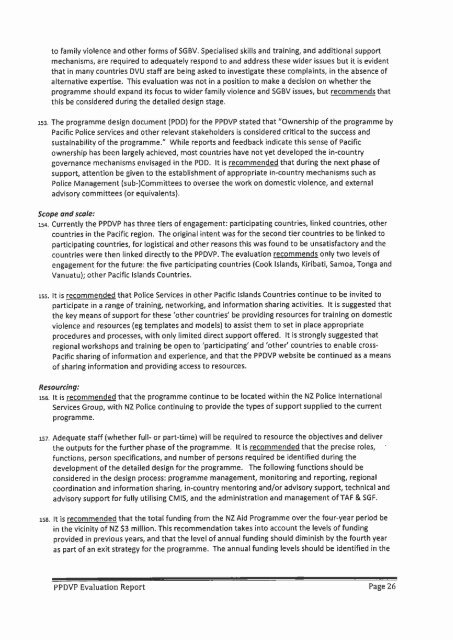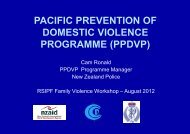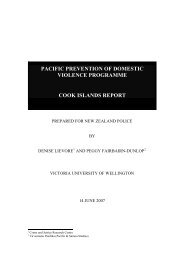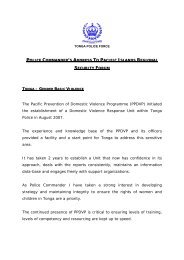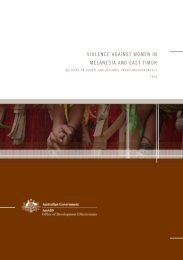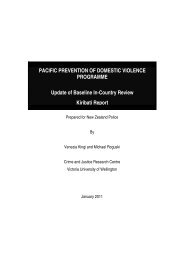PPDVP Evaluation Report - Pacific Prevention of Domestic Violence ...
PPDVP Evaluation Report - Pacific Prevention of Domestic Violence ...
PPDVP Evaluation Report - Pacific Prevention of Domestic Violence ...
Create successful ePaper yourself
Turn your PDF publications into a flip-book with our unique Google optimized e-Paper software.
to family violence and other forms <strong>of</strong> SGBV. Specialised skills and training, and additional supportmechanisms, are required to adequately respond to and address these wider issues but it is evidentthat in many countries DVU staff are being asked to investigate these complaints, in the absence <strong>of</strong>alternative expertise. This evaluation was not in a position to make a decision on whether theprogramme should expand its focus to wider family violence and SGBV issues, but recommends thatthis be considered during the detailed design stage.153. The programme design document (POD) for the <strong>PPDVP</strong> stated that "Ownership <strong>of</strong> the programme by<strong>Pacific</strong> Police services and other relevant stakeholders is considered critical to the success andsustainability <strong>of</strong> the programme." While reports and feedback indicate this sense <strong>of</strong> <strong>Pacific</strong>ownership has been largely achieved, most countries have not yet developed the in-countrygovernance mechanisms envisaged in the PDD. It is recommended that during the next phase <strong>of</strong>support, attention be given to the establishment <strong>of</strong> appropriate in-country mechanisms such asPolice Management (sub-)Committees to oversee the work on domestic violence, and externaladvisory committees (or equivalents).Scope and scale:154. Currently the <strong>PPDVP</strong> has three tiers <strong>of</strong> engagement: participating countries, linked countries, othercountries in the <strong>Pacific</strong> region. The original intent was for the second tier countries to be linked toparticipating countries, for logistical and other reasons this was found to be unsatisfactory and thecountries were then linked directly to the <strong>PPDVP</strong>. The evaluation recommends only two levels <strong>of</strong>engagement for the future: the five participating countries (Cook Islands, Kiribati, Samoa, Tonga andVanuatu); other <strong>Pacific</strong> Islands Countries.15s. It is recommended that Police Services in other <strong>Pacific</strong> Islands Countries continue to be invited toparticipate in a range <strong>of</strong> training, networking, and information sharing activities. It is suggested thatthe key means <strong>of</strong> support for these 'other countries' be providing resources for training on domesticviolence and resources (eg templates and models) to assist them to set in place appropriateprocedures and processes, with only limited direct support <strong>of</strong>fered. It is strongly suggested thatregional workshops and training be open to 'participating' and 'othef countries to enable cross-<strong>Pacific</strong> sharing <strong>of</strong> information and experience, and that the <strong>PPDVP</strong> website be continued as a means<strong>of</strong> sharing information and providing access to resources.Resourcing:156. It is recommended that the programme continue to be located within the NZ Police InternationalServices Group, with NZ Police continuing to provide the types <strong>of</strong> support supplied to the currentprogramme.157. Adequate staff (whether full- or part-time) will be required to resource the objectives and deliver.the outputs for the further phase <strong>of</strong> the programme. It is recommended that the precise roles,functions, person specifications, and number <strong>of</strong> persons required be identified during thedevelopment <strong>of</strong> the detailed design for the programme. The following functions should beconsidered in the design process: programme management, monitoring and reporting, regionalcoordination and information sharing, in-country mentoring and/or advisory support, technical andadvisory support for fully utilising CMIS, and the administration and management <strong>of</strong> TAF & SGF.15s. It is recommended that the total funding from the NZ Aid Programme over the four-year period bein the vicinity <strong>of</strong> NZ $3 million. This recommendation takes into account the levels <strong>of</strong> fundingprovided in previous years, and that the level <strong>of</strong> annual funding should diminish by the fourth yearas part <strong>of</strong> an exit strategy for the programme. The annual funding levels should be identified in the--<strong>PPDVP</strong> <strong>Evaluation</strong> <strong>Report</strong> Page 26


